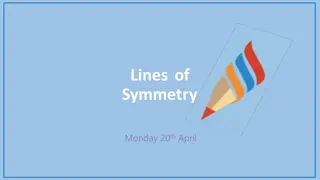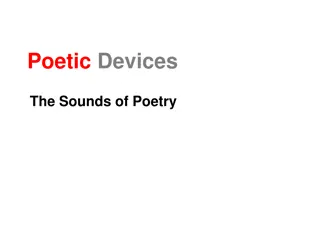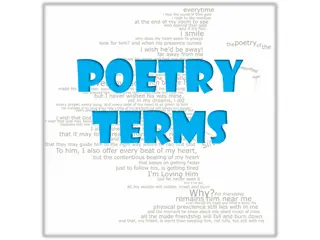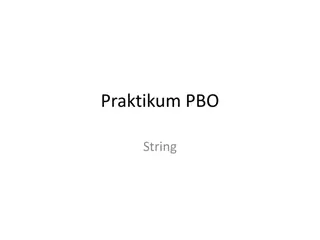Exploring Literary Devices: Alliteration, Symmetrical Alliteration, Palindrome, and Assonance
Delve into the world of poetic devices through examples and explanations of alliteration, symmetrical alliteration, palindrome, and assonance. Discover how these techniques enhance the beauty and rhythm of poetry, from subtle alliteration to symmetrical wordplay and the intriguing symmetry of palindromes.
Uploaded on Sep 23, 2024 | 0 Views
Download Presentation

Please find below an Image/Link to download the presentation.
The content on the website is provided AS IS for your information and personal use only. It may not be sold, licensed, or shared on other websites without obtaining consent from the author. Download presentation by click this link. If you encounter any issues during the download, it is possible that the publisher has removed the file from their server.
E N D
Presentation Transcript
Alliteration Repetition of first, stressed, and consonant sounds in a series of words. It is the first consonant in a word, and it is on a stressed syllable. In alliteration, all of the consonant sounds in a line of poetry do not have to be reused, as in the exaggerated example of Peter Piper picked a peck of pickled peppers where nearly every word begins with a hard p sound. Usually alliteration in poetry is a bit more subtle and natural.
Alliteration Examples: We saw the sea sound sing, we heard the salt sheet tell Dylan Thomas And the silken sad uncertain rustling of each purple curtain Edgar Allan Poe
The Labyrinth by Robert P. Baird Torn turned and tattered Bowed burned and battered I took untensed time by the teeth And bade it bear me banking Out over the walled welter an example of alliteration in a cool poem cities and the sea Through the lightsmocked birdpocked cloudcocked sky To leave me light on a lilting planetesimal. The stone walls wailed and whimpered The bold stars paled and dimpled Godgone time gathered to a grunt And bore me bled and breaking On past parted palisades windrows and the trees Over a windcloaked nightsoaked starpoked sea To drop me where? Deep in a decadent s dream.
Symmetrical Alliteration Sort of like a palindrome: racecar But with a line of poetry: rust brown blazers rule rbbr purely and fundamentally for analytical purposes paffap black and white, white and black bawwab
Palindrome Word, phrase, sentence that reads the same backward and forward. Examples: civic hannah level A man, a plan, a canal Panama! Elite Tile Can be word for word instead of letter for letter: fall leaves when leaves fall
Assonance Repetition of vowel sounds without repeating consonants. Vowel Rhyme He gives his harness bells a shake To ask if there is some mistake. The only other sound s the sweep Of easy wind and downy flake. The woods are lovely, dark and deep. But I have promises to keep, And miles to go before I sleep, And miles to go before I sleep Robert Frost E: He, sweep, easy, downy, lovely, deep, keep, sleep I: gives, his, if, is, mistake notice also the o and a sounds
Poetry is old, ancient, goes back far. It is among the oldest of living things. So old it is that no man knows how and why the first poems came. Carl Sandburg assonance in o
Onomatopoeia Sounds Effects for your Poems! A word which imitates the sound of a thing. Examples: choo choo hiss buzz boom tinkle splash thump murmur whisper gush pop toot rumble sizzle drip swoosh neigh
Sprung Rhythm Gerard Manley Hopkins created this form. Lines of the poem begin with stressed syllables. Each line has one to four beats. Number of beats varies from line to line. Tries to reflect common speech while still being structured. Influenced free verse.
Pied Beauty Glory be to God for dappled things For skies of couple-colour as a brinded cow; For rose-moles all in stipple upon trout that swim; Fresh-firecoal chestnut-falls; finches' wings; Landscape plotted and pieced fold, fallow, and plough; And all trades, their gear and tackle and trim. All things counter, original, spare, strange; Whatever is fickle, freckled (who knows how?) With swift, slow; sweet, sour; adazzle, dim; He fathers-forth whose beauty is past change: Praise him. example of Sprung Rhythm by Hopkins
Cadence Describes the rhythmic rise and fall of language. Cadence describes the natural order of beats in speech. Non-syllabic verse. No distinct meter. It is not the sunset Nor the pale green sky Shimmering through the curtain Of the silver birch, Nor the quietness; It is not the hopping Of the little birds Upon the lawn, Nor the darkness Stealing over all things That moves me London by F. S. Flint























